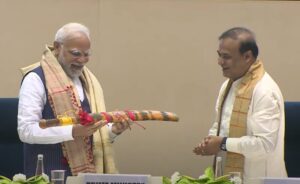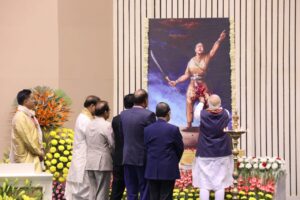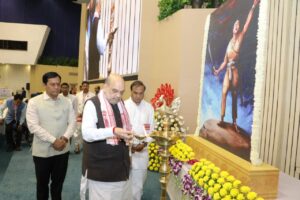by Nava J Thakuria 2 December 2022
It was a crowded Vigyan Bhawan in New Delhi with a large number of
distinguished personalities from Assam as participants on 25 November,
where Prime Minister Narendra Modi addressed the closing ceremony of
the year-long celebration of 400th birth anniversary of 17th century
Ahom army general Lachit Barphukan. Terming the extraordinary Ahom
warrior as the greatest patriot of his era, PM Modi stated that
Lachit’s policy of Nation First is exactly the motto on which the Naya
Bharat is being administered. For Vir Lachit his motherland was his
first priority and that’s why he could pronounce ‘Deshatkoi Momai
Dangor Nahay’ (maternal uncle cannot be superior to the country),
asserted Modi.
Congratulating Assam chief minister Himanta Biswa Sarma for successful
conduct of the three-day celebration in the Indian national capital
city, Modi exuded confidence this would prove decisive in ensuring
Lachit saga of courage, valour and patriotism don’t remain limited to
the boundaries of northeast India alone, but spread across lengths and
breadths of the nation. For ages, there has been a conscious attempt
from certain quarters at portraying the history of Bharat as that of
defeat and surrender, stated Modi adding that attempts at celebrating
the saga of unsung heroes such as Lachit are going to prove fruitful
in undoing the harm the distorted history-telling has caused to the
pride of the Indian citizens.
Suppressing the self-esteem of the Indians was an agenda of the
colonial British regime and distortion of history was one of the means
to further it, Modi pointed out adding, all must now come together to
ensure history is presented in its truest sense. Modi also mentioned
about legendary Assamese singer Bharat Ratna Bhupen Hazarika, who
composed a number of songs praising the bravery of Lachit, and termed
the Ahom general as a symbol of India’s Atmanirbhar military might.
Lachit Barphukan (24 November 1622- 25 April 1672) was born at
Charaideo, the first capital of Ahom kingdom, to Momai Tamuli Barbarua
(who was an army chief under Ahom king Pratap Singha) and Kunti Moran.
Grown up as Lachit Deca, the warrior received formal education in
military training & strategies and soon got an appointment as
Soladhara Barua to the Ahom monarch. He worked as a security personal
to Ahom king Jayadwvaj Singha. Later he was promoted as a top army
officer and emerged as Lachit Barphukan (Barphukan was a post with
judicial and executive power).
After the demise of Jayadhwaj Singha, Chakradhwaj Singha took over the
charge of Ahom kingdom and appointed Lachit Barphukan as the
commander-in-chief of Royal Ahom army. Presenting him a Hengdang
(sacred sword), the king ordered Lachit Barphukan to lead the
indigenous forces for liberating Guwahati from the occupation of
Mughals. Lachit raised an army out of civilians who were mostly
farmers from different ethnic communities and initiated guerilla
warfare before the final assault. Chakradhwaj Singha died in 1670 and
Udayaditya Singha became the king during whose tenure the Saraighat
battle was won by Lachit Barphukan with valuable suggestions from
minister Aton Burha Gohain.
In the naval battle of Saraighat, Lachit Barphukan crushed the huge
Mughal forces, which came under the leadership of Ram Singh and Rashid
Khan following the order of Mughal emperor Aurangzeb in Delhi. Even
though the Ahom forces were inferior to the invading Mughals, Lachit
succeeded in the battle over mighty Brahmaputra river with a perfect
war strategy, a dedicated navy force and proper uses of the
hill-river-valley terrain. After the extraordinary naval battle in
1671 (where the moment of counter attack was calculated by the Royal
astrologer). Mughals forces retreated from Guwahati and they could not
reorganise to invade the kingdom again. Lachit died at his Kaliabor
headquarters in 1672.
CM Sarma in his speech exuded confidence Lachit Barphukan would be
accorded his rightful place in historical discourses in days to come,
as more and more people are introduced to the velour of the great
warrior. He stated that had it not been for Mahanayak Lachit, the
present geo-political and cultural identity of not Assam alone but
that of the entire southeast Asia would have been different from what
they are today. Sarma expressed hope that the 400th birth anniversary
celebration of the great mediaeval era warrior in New Delhi would be a
significant step towards drawing the attention of the current
generation intellectuals and historians towards Lachit
Assam Governor Jagdish Mukhi, Union minister Sarbananda Sonowal, State
legislative assembly speaker Biswajit Daimary, State minister Pijush
Hazarika, Rajya Sabha member Ranjan Gogoi, Parliamentarian Tapan
Gogoi, State chief secretary Pawan Barthakur also graced the occasion,
where Sarma expressed his gratitude towards the people of Assam for
their support and cooperation to the celebration, which was launched
by the then President Ram Nath Kovind during his visit to Assam on 25
February 2022. President Kovind also laid the foundation stone for the
Alaboi war memorial as a tribute to soldiers who fought against the
Mughals.
Earlier on previous day, Union home minister Amit Shah attended the
celebration and commented that Lachit prevented Mughal emperor
Aurangzeb’s expansionist ambition towards the southeast Asian nations
and thus the Ahom warrior was a central force to stop the Islamisation
of a large swathe of land spanning several nations, cultural
identities and ethnicities. He also lauded Vir Lachit’s skillful
negotiations with various ethnic leaders to form a united front
against the invaders and clever use of diplomacy against the
militarily stronger Mughal forces.
The celebration in Delhi was inaugurated by Union finance minister
Nirmala Sitharaman on 23 November, where she also opened two
exhibitions, one on Assamese sacred and traditional houses (designed
by Nuruddin Ahmed) and another with artefacts from the Ahom and
pre-Ahom era starting from the reign of Kamrup king Kumar Bhaskar
Varma and also some handwritten letters of Vir Lachit. A panel
discussion on ‘Ahom saga of hope, skills and courage’ was organised at
the same venue which participated by Lt. General Rana Pratap Kalita,
former State police chief Prakash Singh along with Kapil Kapoor,
Kuldeep Patowary, Chandan Kumar Sarma and Samundra Gupta Kashyap,
which was moderated by former State chief secretary Jishnu Barua.
Another discussion on ‘Ignored historiography of Assam’s assertion’
was participated by Gauhati University professor Rajib Handique,
author Vikram Sampath, Mangaldoi College teacher Sangeeta Gogoi,
filmmaker Rajesh Kumar Singh and actor Chandraprakash Dwivedi, which
was moderated by State education advisor Nani Gopal Mahanta.
Deliberations included the heroic saga of Kamrupa king Prithu, who
overpowered Muslim invader Bhakhtiyar Khilji, glorious days of Bhaskar
Varma, laudable effort of Assamese historian Suryya Kumar Bhuyan, who
picked up the inspiring story of Lachit Barphukan and common
residents, be ready for battles to fight and safeguard the motherland.
The tale of Bagh Hazarika was raised in the discussion, where it was
profoundly declared that the Ahom history pages do not include any
such warrior in association with Lachit Barphukan. History teacher Ms
Gogoi firmly stated that she did not have any authentic information
about the presence of Bagh Hazarika. Earlier, a recognized Assamese
historian Jogen Phukan also termed Bagh Hazarika or Ismail Siddiqui as
an imaginary character. Mentionable is that a section of Assamese
intellectuals claimed in various forums that Lachit emerged victorious
in the Saraighat battle only because of Bagh Hazarika. Even the statue
of Lachit Barphukan in Guwahati accompanies a soldier looked like a
Muslim.
On the first day itself, a cultural function was inaugurated by CM
Sarma and Union law & justice minister Kiren Rijiju at Sunder nursery,
in presence of Union minister Rameswar Teli and State minister Bimal
Bora, where various artistes showcased splendid items including a
traditional prayer of Tai-Ahom community, a Sattriya dance program by
Mridusmita Das Bora and her team, a medley of folk dances of Assam
presented by maestro Ranjit Gogoi, an emotionally charged drama
depicting the illustrious life of Vir Lachit and solo an enchanting
performance by popular Assamese singer Angarag Papon Mahanta.
The author is a journalist based in northeast India



